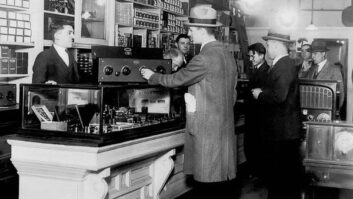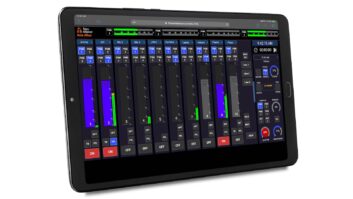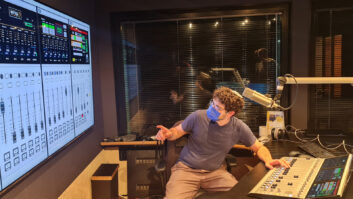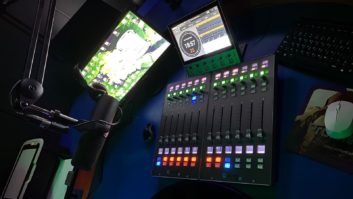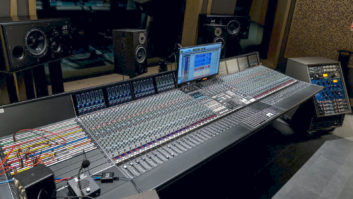Radio Skonto serves the Riga, Latvia market in northern Europe, on the Baltic Sea across from Stockholm, Sweden. Their new studios, powered with Axia Livewire technology, were installed in May 2004. Steve Church spoke with Valdis Melderis, program director and morning show host, and with chief engineer, Ivo Bankavs.
Axia: Most readers will not know much about Riga or Latvia. Can you fill us in?
Melderis: Yeah, we’re not so well known, I understand. Perhaps I can do a small part to advance people’s awareness of us. Our country has just joined NATO and the European Union, so there is a lot of obvious change in the air these days. Actually, change has been a constant for the last years. In the decade since we achieved independence, Riga has been transformed into a stylish center of art, fashion and nightlife. It is also a technology-rich area with mobile phones and DSL internet connections as a routine part of daily life. Riga was famous for technology during the Soviet days, with a huge radio and consumer electronics company being based here, as well as a major telephone equipment and semi-conductor manufacturer, so I guess we have interest for the latest tech things in our blood.
Axia: Tell me a little about your station.
Melderis: We are owned partly by MetroMedia in the U.S., so we operate pretty much like an American station. We are live, 24-hours-a-day. Our main programming is music, but we have an active morning show and a local news department. Riga is a major market with a population over 1 million and has a very competitive radio situation, so we are focusing on a specific segment with our mix of international and local music. I guess we would be called “soft rock” in the USA.
Axia: What about the technical side?
Melderis: That’s pretty typical American-style, as well. Our first studios were done a few years ago by our engineers along with Phil Harris, a MetroMedia guy from the U.S., so we were built with equipment your American readers probably know: Wheatstone consoles, Denon CD players, Mosely STL, EV mics etc. One thing unique to us and the other MetroMedia stations in the region is that we use a PC delivery system invented by one of our own people.
Axia: Ivo, were you concerned about using Ethernet for audio?
Bankavs: No. I had seen the demonstrations and asked a lot of questions. Your answers convinced me that it would work.
Axia: And has it been OK? What can you say now after a few months on the air?
Bankavs: We’ve had no failure or downtime of any kind since we installed it, so there’s your answer. You guys did warn us that this is all very new and that we would be among the first to use it, so we were ready for start-up bugs. But we’ve been happy that there have been none.
Axia: None?
Bankavs: Well, there was one, sort-of. The SmartSurface clock was running fast and we had to re-set it every day to keep it in sync. When we asked the guys from the University about this (Ed: University of Riga, our European development partners), they explained about using the NTP Server to get the time over the network. Now we have a bit of software running in our delivery computer that serves NTP time over the Ethernet. The Surface picks this up and is now always in perfect sync to the delivery PC.
The operators had some ideas about how some of the features should work differently, as Valdis [Melderis ] explained, but these were not serious problems.
Axia: How was the installation?
Bankavs: Very smooth, and much simpler than the old analog set-up was. There are lot fewer cables, which we prepared in advance. That took a couple of days. Actually the RJ-45s went fast, but we had a few GPIOs to wire up and that took some time to match up the right connector pins, make sure the polarity was right, get the wires soldered on, etc. Then, one day at midnight, we patched our delivery PC directly into the audio processor to stay on the air, and moved all the old stuff out and the new equipment in. Four hours later, we were on the air with it.
Axia: Do you see any advantage or disadvantage to using Ethernet to connect the equipment together?
Bankavs: It’s a lot different with regard to deep technology, but it’s pretty much the same as analog from an installation and user perspective: You plug this into that and it works. The RJs were a lot faster to install than analog plugs and there are not so many cables, so things are generally simpler and the wiring neater. For example, there’s only one cable from the SmartSurface; we had a lot of them going to our old console! We’re a smaller station, so we’re not taking so much advantage of the routing functions in the Ethernet switch, but I can see how that aspect would be really nice for bigger stations.
Axia: What about interfacing to your PC delivery system?
Bankavs: At first, we were using a sound card in the PC to feed the Livewire terminal, and that was OK. But when our software guru came back from holiday, we changed to the Windows IP-Audio driver, so now we’re direct digital into the network. Since the driver looks like a sound card to the computer, it was pretty straight-forward. There was some usual Windows strangeness with the installation, but it was resolved. We kept the soundcard installed for backup; it would be easy to re-direct the player to the card if we need to.
For more information, please go to Axia’s Website at www.axiaaudio.com.
